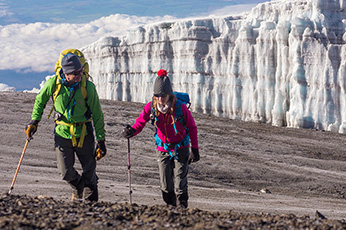
Head Lamp: Several head lamps of various models are available in the marketplace of the brands Petzl and Black Diamond. Pick the ones providing multiple lighting levels, LED bulbs and using AAA batteries.
It is advised to bring in a minimum of three sets of spare batteries so that you can enjoy interrupted lighting on your summit attempt.
Camp shoes (Crocs/Teva/Sandals) : These shoes are ideal for camping and walking along a hiking trail in any mountain. These can also be used for creek crossing and might be higher than a boot. For warmer climates, you can wear a flip-flop.
Hydrator: When you have to trek for non-stop hours, hydrators allow you to drink water slowly and frequently without interrupting your hiking tour. A capacity of 2-3 liters is usually considered good and should easily fit into your pack. The Camelbaks come with a bite valve, on/off switch, and a large access port for pouring water into the container. A NEOPRNE SLEEVE is highly necessary for preventing the water from freezing.
Bug Spray:YDEET based products work well and we find that the spray on versions last longer and are less messy. 4-6 ounce repellents that are perspiration and splash resistant are great.
Sun Screen :A good sunscreen with a rating of SPF 30 or higher is recommended. Favourably, it should be water and sweat proof. 8 ounces per person is more than enough for a tour. We usually carry SPF 45 sunscreen for our face and SPF 30 for exposed areas. Kinesis, REI, Banana Boat, and All Terrain are good options.
2 wide mount water bottles : A 1 liter water bottle is essential for hydrating at lunch, around the camp, and refilling throughout the day. Stay away from glass and heavy metals and look for Lexan for durability *For males a third water bottle should be considered for use as a potty at night and must be labeled accordingly.
Pillow: A Thermarest pillow that compresses down or folds into itself is ideal. A good benchmark for size and weight are 18 X 14 inches and 9 ounces total.
Dry Bag : A 20 liter + dry bag is great for ensuring your personal items are safe in case of rain. Cameras, wallets, money, and any other valuables can be kept dry at all times.
Pack Cover : The pack cover is an additional item we recommend everyone carry in case we encounter heavy rains. The pack cover should have a drawstring cord and elastic edges to fit firmly over your bag. A 40 liter cover will work well on any day pack.
Trekking Poles: Collapsible poles are great for steep downhill terrain and assistance up hill. If you have knee problems they reduce the impact on your joints by 20-30%. A nice soft foam grip will help prevent blisters and the poles with an aluminum shaft are durable and light weight.
Camp Towel: The camp towel should be of a polyester nylon blend that dries quickly and compacts tightly in your pack. The large (50 X 27 inches) is a good size and can be used to wash up at the end of the day. Stay away from house or beach towels.
IN GENERAL, THERE ARE FOUR TYPES OF LAYERS
Base Layer: The main objective of a base layer is to maintain dryness and put a comfortable microclimate next to your skin. The layer therefore absorbs all the moisture and then transfers it to the surface layers from where it will eventually evaporate. Typical innermost base layer fabrics are Polartec Power Dry, CoolMax, Patagonia Capilene, and wool.
Second Base Layer: The second layer will do its magic and provide more warmth in case the base layer and shell layer aren’t enough for insulation. It does so by trapping small pockets of air in the fabric and hence slows down the loss of heat. Popular fabrics are Polartec Classics, Berber pile, and Wind stopper.
Third Base Layer: The shell layer which is the third one is designed to provide protection against rain, wind, sleet, and snow without allowing any room for condensation inside the clothing system. It also allows moisture vapour to pass through. Fabrics used for shell layer are Gore-Tex, Hyvent, Aqua-Dry, and Dri-Lite.
Fourth Base Layer: It is enough for most people to have the first three layers. However, in extremely cold conditions, you will need to add a large amount of insulation as a fourth layer. Down and Polarguard can both be used for this layer. This layer is either worn as a shell layer or underneath the shell layer for added warmth on summit bids or high camps.
© 2022 ,Kilitwende Adventures Limited. All rights reserved.